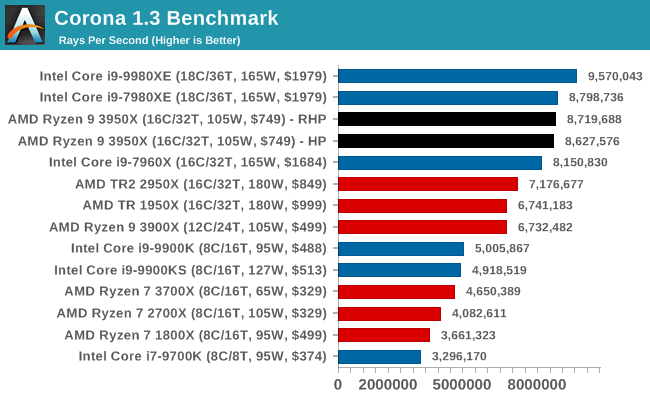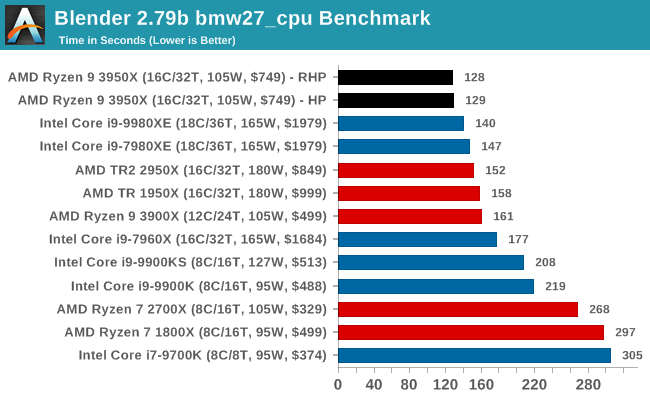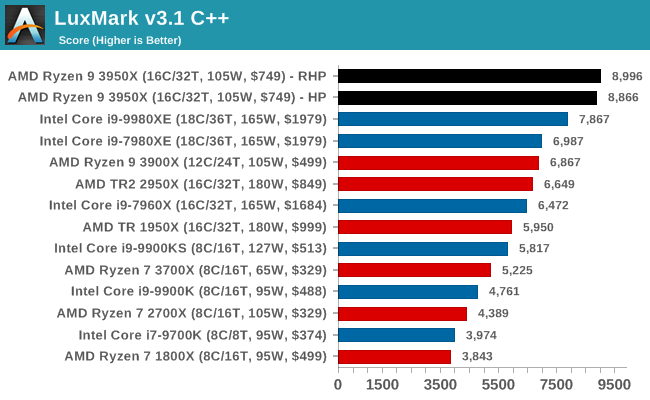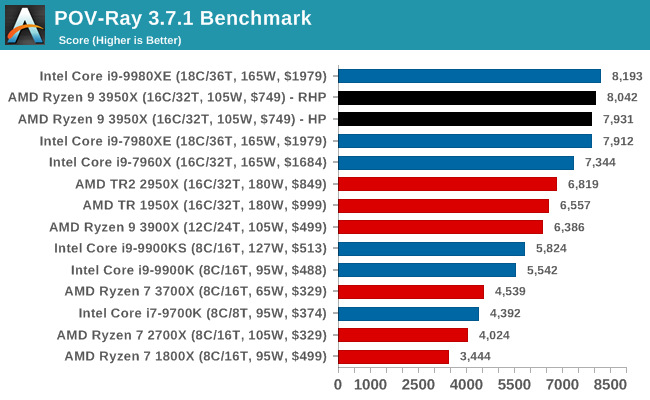The AMD Ryzen 9 3950X Review: 16 Cores on 7nm with PCIe 4.0
by Dr. Ian Cutress on November 14, 2019 9:00 AM ESTCPU Performance: Rendering Tests
Rendering is often a key target for processor workloads, lending itself to a professional environment. It comes in different formats as well, from 3D rendering through rasterization, such as games, or by ray tracing, and invokes the ability of the software to manage meshes, textures, collisions, aliasing, physics (in animations), and discarding unnecessary work. Most renderers offer CPU code paths, while a few use GPUs and select environments use FPGAs or dedicated ASICs. For big studios however, CPUs are still the hardware of choice.
All of our benchmark results can also be found in our benchmark engine, Bench.
Corona 1.3: Performance Render
An advanced performance based renderer for software such as 3ds Max and Cinema 4D, the Corona benchmark renders a generated scene as a standard under its 1.3 software version. Normally the GUI implementation of the benchmark shows the scene being built, and allows the user to upload the result as a ‘time to complete’.
We got in contact with the developer who gave us a command line version of the benchmark that does a direct output of results. Rather than reporting time, we report the average number of rays per second across six runs, as the performance scaling of a result per unit time is typically visually easier to understand.
The Corona benchmark website can be found at https://corona-renderer.com/benchmark

Intel's HEDT chips are quite good at Corona, but if we compare the 3900X to the 3950X, we still see some good scaling.
Blender 2.79b: 3D Creation Suite
A high profile rendering tool, Blender is open-source allowing for massive amounts of configurability, and is used by a number of high-profile animation studios worldwide. The organization recently released a Blender benchmark package, a couple of weeks after we had narrowed our Blender test for our new suite, however their test can take over an hour. For our results, we run one of the sub-tests in that suite through the command line - a standard ‘bmw27’ scene in CPU only mode, and measure the time to complete the render.
Blender can be downloaded at https://www.blender.org/download/

AMD is taking the lead in our blender test, with the 16-core chips easily going through Intel's latest 18-core hardware.
LuxMark v3.1: LuxRender via Different Code Paths
As stated at the top, there are many different ways to process rendering data: CPU, GPU, Accelerator, and others. On top of that, there are many frameworks and APIs in which to program, depending on how the software will be used. LuxMark, a benchmark developed using the LuxRender engine, offers several different scenes and APIs.
In our test, we run the simple ‘Ball’ scene on both the C++ code path, in CPU mode. This scene starts with a rough render and slowly improves the quality over two minutes, giving a final result in what is essentially an average ‘kilorays per second’.

Despite using Intel's Embree engine, again AMD's 16-cores easily win out against Intel's 18-core chips, at under half the cost.
POV-Ray 3.7.1: Ray Tracing
The Persistence of Vision ray tracing engine is another well-known benchmarking tool, which was in a state of relative hibernation until AMD released its Zen processors, to which suddenly both Intel and AMD were submitting code to the main branch of the open source project. For our test, we use the built-in benchmark for all-cores, called from the command line.
POV-Ray can be downloaded from http://www.povray.org/

POV-Ray ends up with AMD 16-core splitting the two Intel 18-core parts, which means we're likely to see the Intel Core i9-10980XE at the top here. It would have been interesting to see where an Intel 16-core Core-X on Cascade would end up for a direct comparison, but Intel has no new 16-core chip planned.











206 Comments
View All Comments
rocky12345 - Friday, November 15, 2019 - link
Great review thanks. I do have to nit pick though. You seem to be scolding AMD for the Zen 2 CPU's slightly going over the stated power limits. I found this a bit odd because of you look at Intel CPU's and how they sated their power limits. You will hardly ever see them coming even remotely close to the stated power limit because their CPU's under full load are pulling much more power than stated by Intel.Example the 9900K/9900KS have been seen pulling almost double the power as stated by Intel under stock conditions. Yes I understand AMD & Intel list their TDP power limits differently and on the Intel side those numbers mean very little unless you lock them at their base clocks without ever letting them go into turbo boost mode.
kc77 - Friday, November 15, 2019 - link
I noticed that as well. I'm noticing less and less TDP comparisons.ajlueke - Friday, November 15, 2019 - link
" the motherboard choice (as well as the cooling it uses) will matter."AMD has really been pushing the idea that VRMs and cooling will affect Ryzen 3000 series performance (likely to sell X570 motherboards), but I haven't come across any actual supporting data.
In my experience, the Ryzen 3000 series winds up voltage bound by FIT, well below excessive temperature or PPT, TDC, EDC bounds. Such that any additional headroom, like from a custom loop or better VRMs accomplishes nothing.
Now, the statement I quoted above is pretty definitive that it does matter. So I imagine, there is data supporting it. Care to share?
rickderick7 - Friday, November 15, 2019 - link
I bought AMD Ryzen 9 3950X last week, and set it up on my CPU , but since then my printer stopped working. Is that something related to this device? I even tried setting up the printer again with the below steps in the link, but still no luck. I need my printer working as before.Could someone advice on this?
Thanks
Rick
rickderick7 - Friday, November 15, 2019 - link
I bought AMD Ryzen 9 3950X last week, and set it up on my CPU , but since then my printer stopped working. Is that something related to this device? I even tried setting up the printer again with the below steps in the link, but still no luck. I need my printer working as before.https://123hp-com-setup.us/123hp-oj5255-wireless-s...
Could someone advice on this?
Thanks
Rick
Drazick - Saturday, November 16, 2019 - link
It has nothing to do with the CPU be it Intel or AMD.Supercell99 - Friday, November 15, 2019 - link
All these comments and I haven't read one useful one yet.Rudde - Friday, November 15, 2019 - link
It appears that AMD's PPT power limit is 35% higher than their TDP.Drazick - Saturday, November 16, 2019 - link
It is about time we move to Quad (4) Memory Channels in consumer computers.csell - Saturday, November 16, 2019 - link
Or DDR5 RAM. I expect the DDR5 RAMs to arrive first.